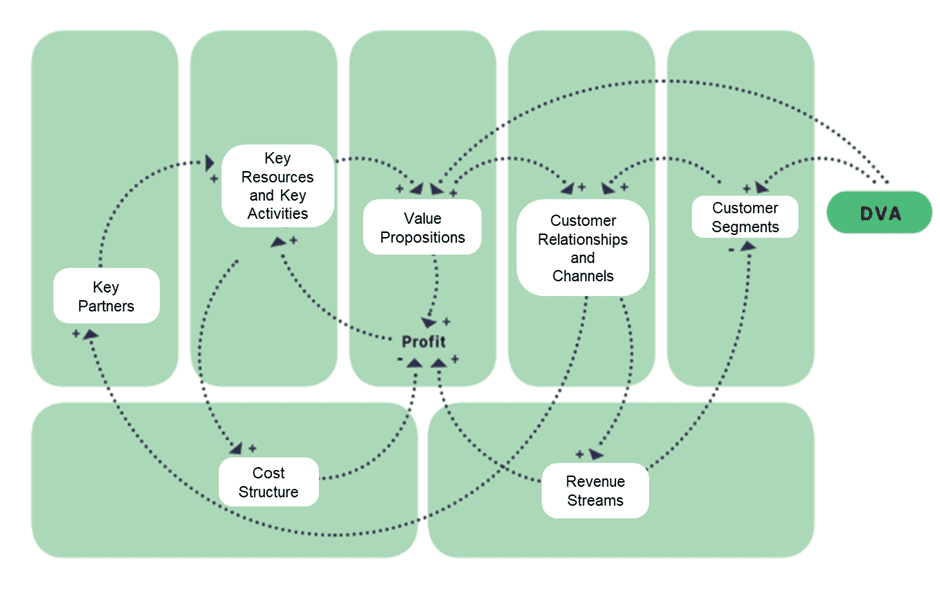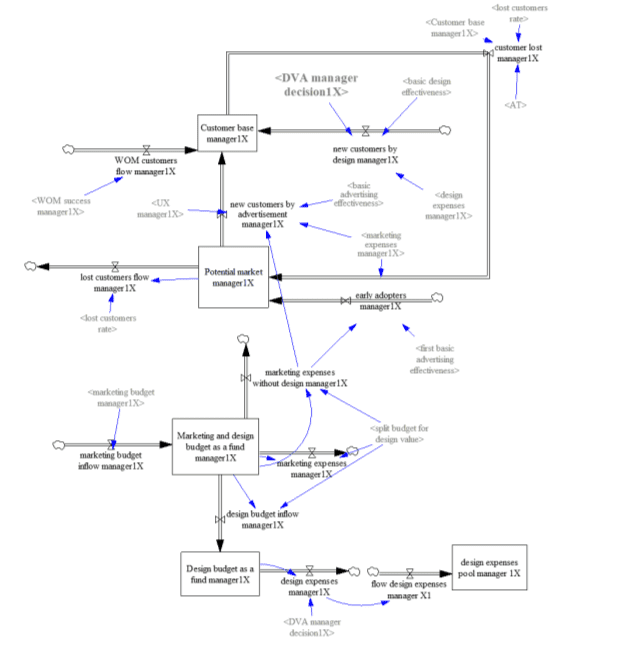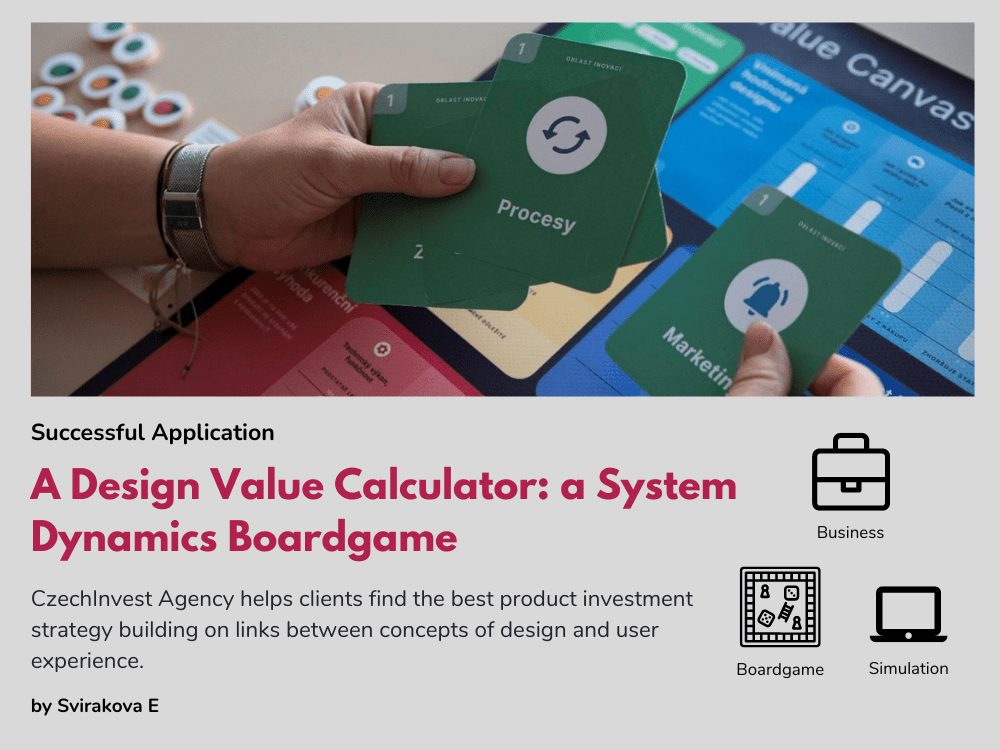A Design Value Calculator: A System Dynamics Boardgame
EXECUTIVE Summary
-
Product design is a specific form of complex innovation that touches all areas of an organization’s management. While entrepreneurs recognise the value of design, they often tend to focus on areas that customers recognise as important but that they are often already happy with. Helping entrepreneurs to systemically assess the benefits of spending on developing different aspects of the user experience is, hence, fundamental to increase the return over investment and to improve business sustainability.
-
To address this, the CzechInvest Agency developed an interactive board game powered by a System Dynamics model simulator that simulates the economic development of a company over six years and calculates the profitability of changes made to the product design.
-
Based on the game results, the Agency presents opportunities to improve product design. The company’s management can thus objectively identify weaknesses and chooses a strategy to design a better product that improves profits.
#CzechInvest #ProductDesign #Innovation #CzechRepublic
The Problem
Entrepreneurs face a multitude of challenges when it comes to product design, ranging from understanding user needs to navigating technical constraints. One of the primary hurdles is identifying and addressing the true pain points of their target audience. Without a deep understanding of user behavior, preferences, and expectations, entrepreneurs risk developing products that fail to resonate with their intended market.
Additionally, entrepreneurs often fail to understand the concept of product design focusing too much on a particular aspect of their product (often the way it looks) neglecting other aspects of it. While the product presentation is important it is only one part of product design and entrepreneurs need to have a holistic view of the product balancing user-centric design with technical feasibility and cost considerations. In short, entrepreneurs need to ensure that their product ideas are not only desirable but also manufacturable and economically feasible.
The Solution
The solution developed consists of a board game and a complementary System Dynamics model. The game covers five areas of innovation that players can decide to invest on, and the simulation model is used to estimate the performance of these investments. The five areas of innovation players can select by placing a card on the boardgame are: i) services (Služby) ii) Marketing methods, iii) Customer Relationships (Vztahy se zákazníky), iv) Goods and products (Zboží), and v) Internal Company Processes (Procesy).
Once the player has selected an area, the performance of the players decision is estimated using a System Dynamics model designed for this purpose. The figure shows an overview of the building blocks of the System Dynamics model and their links. A customer segment is a group of people or organizations that a company wants to attract and create value for through an appropriate value proposition. The larger the customer segment, the more customer relationships to manage and the busier the distribution channels. Every sale means billing, and billing is a source of revenue. Higher revenue means higher PROFIT for the company, thus growing key resources, one of which is the bank account. The more money in the bank account, the better it is to buy assets, hire new employees, increase product production capacity, and expand the distribution network.

The Design Value Algorithm (DVA) coefficient enters the model in the Customer Segment building block (see figure of the Stock and Flow diagram) and thus influences all other elements in the model. The input of the DVA coefficient to the Customer Segment can also be verified in the Business Algorithms in the Dynamic Business Model illustration.

The winner of the game can be determined either:
a) by the evolution of PROFIT’s cumulative profit with other players.
b) by looking at the impact of the design improvements made during the game.
Outcomes
CzechInvest clients implemented this solution and offers structured interviews to company management. The game demonstrates a systemic link between the concepts of design and user experience and quickly reveals the best strategy for further investment in product design.
Below there are some examples and comments from one of the customers that played the game:
Client Number 1X – XYZ Ltd: “The measured value of design is the difference between the evolution of the PROFIT indicator that the company generates without investing in design (the blue curve in the graph) and the evolution of the profit that the company generates based on the decision to invest in design (the other three curves). The value of design is a dynamic indicator that changes over time.”

Interpretation for the client 1X – XYZ Ltd: “The company needs to invest in design; in this situation, where its average UX is 66%, it is profitable. “
According to the parameters given: the average UX (User Experience) = 0.66. This means that the company can still increase user experience by 34%. However, the manager did not make a strategic decision to earn more on design. Instead, he chose a strategy that is not in line with the company’s potential to increase UX. He placed investments in improving the functionality of the product first and investments in distribution third. In doing so, he identified the lowest UX sub-value in sales. If he wants to serve his customers better, he needs to strategically address sales first.
Do you want to know more?
Visit the Design Value Calculator or connect with Eva Svirakova.
OTHER SUCCESSFUL APPLICATIONS
Solving Bottlenecks in Dairy Production Facilities with System Dynamics
Solving Bottlenecks in Dairy Production Facilities with System Dynamics EXECUTIVE Summary FrieslandCampina faced potential bottlenecks in production due to the merging of two factories. They hired SD&Co which employed system dynamics simulation models to predict...
The World Bank Uses System Dynamics to Identify Root Causes of Poverty
The World Bank Uses System Dynamics to Identify Root Causes of Poverty EXECUTIVE Summary Madagascar has one of the highest poverty rates in the world. In 2022, an astonishingly three out of every four people in Madagascar lived below the poverty line. Poverty has...
Fast-Track Cities Uses System Dynamics to Enhance HIV Care
Fast-Track Cities Uses System Dynamics to Enhance HIV Care EXECUTIVE Summary Low levels of viral suppression at 69% for people with HIV make it hard to believe the 95% target level will be achieved by 2030 in St. Louis, USA. As a solution, Fast-Track Cities-STL opted...
Upcoming Events
Health Policy SIG Networking and Collaboration Event
Please join us for our quarterly Health Policy SIG virtual social hour! Agenda: TBD
Recent Posts
Society Governance Updates
Society Governance Updates Welcome, Allyson! New President Allyson Beall King joined the Policy Council as our 2024 President. Her primary role is as director of the Washington State University School of the Environment, which focuses on regional ecologies and our...
Call for Presenters: Seminar Series
Call for Presenters: Seminar Series We at the System Dynamics Society are continually seeking vibrant and knowledgeable presenters for our ongoing Seminar Series. As we unfold the calendar, there’s always a place for more insights, experiences, and expertise to enrich...
Honoring Excellence: A Glimpse into the Awards of the International System Dynamics Conference
Honoring Excellence: A Glimpse into the Awards of the International System Dynamics Conference The International System Dynamics Conference brings together experts, practitioners, and students to exchange ideas, showcase real-world applications, and celebrate...
Join us
OTHER SUCCESSFUL APPLICATIONS
Solving Bottlenecks in Dairy Production Facilities with System Dynamics
Solving Bottlenecks in Dairy Production Facilities with System Dynamics EXECUTIVE Summary FrieslandCampina faced potential bottlenecks in production due to the merging of two factories. They hired SD&Co which employed system dynamics simulation models to predict...
The World Bank Uses System Dynamics to Identify Root Causes of Poverty
The World Bank Uses System Dynamics to Identify Root Causes of Poverty EXECUTIVE Summary Madagascar has one of the highest poverty rates in the world. In 2022, an astonishingly three out of every four people in Madagascar lived below the poverty line. Poverty has...
Fast-Track Cities Uses System Dynamics to Enhance HIV Care
Fast-Track Cities Uses System Dynamics to Enhance HIV Care EXECUTIVE Summary Low levels of viral suppression at 69% for people with HIV make it hard to believe the 95% target level will be achieved by 2030 in St. Louis, USA. As a solution, Fast-Track Cities-STL opted...
Recent Posts
Society Governance Updates
Society Governance Updates Welcome, Allyson! New President Allyson Beall King joined the Policy Council as our 2024 President. Her primary role is as director of the Washington State University School of the Environment, which focuses on regional ecologies and our...
Call for Presenters: Seminar Series
Call for Presenters: Seminar Series We at the System Dynamics Society are continually seeking vibrant and knowledgeable presenters for our ongoing Seminar Series. As we unfold the calendar, there’s always a place for more insights, experiences, and expertise to enrich...
Honoring Excellence: A Glimpse into the Awards of the International System Dynamics Conference
Honoring Excellence: A Glimpse into the Awards of the International System Dynamics Conference The International System Dynamics Conference brings together experts, practitioners, and students to exchange ideas, showcase real-world applications, and celebrate...
Upcoming Events
Health Policy SIG Networking and Collaboration Event
Please join us for our quarterly Health Policy SIG virtual social hour! Agenda: TBD


